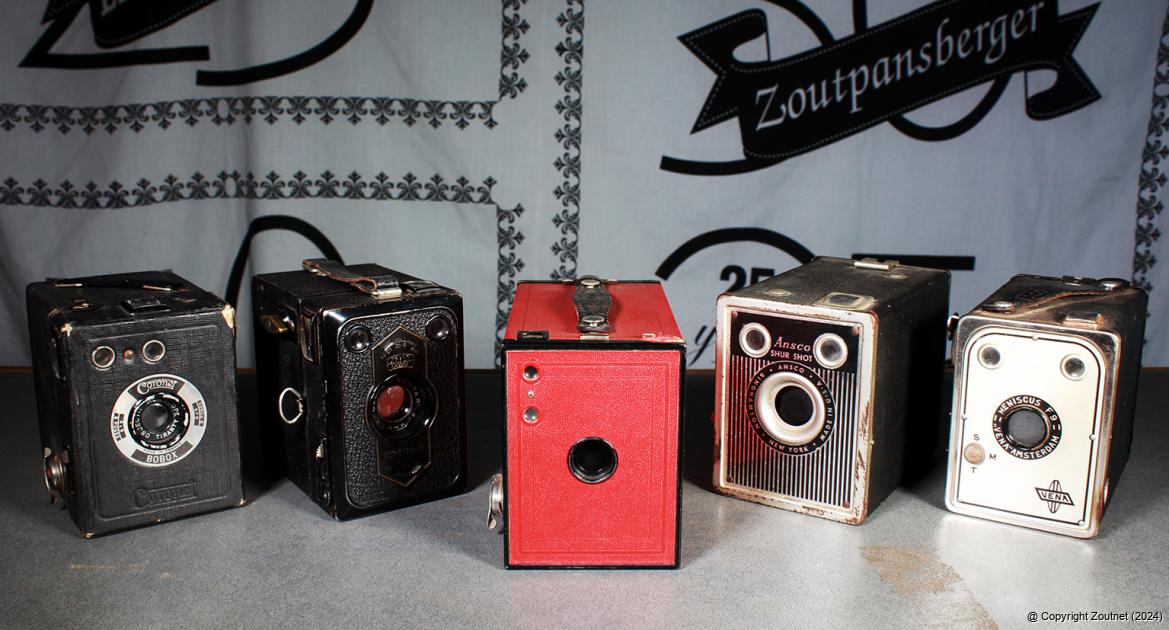

ADVERTISEMENT:

A couple of the box cameras in the Zoutpansberger's photographic museum. These can all be used during the workshop.
Bring your box camera along and take some photos
To start off the Zoutpansberger’s annual vintage photography competition, a “Box Camera Day” will be held at the offices of the newspaper next Saturday.
All photographers, whether amateur, very amateur or even clueless, are welcome to attend the workshop and photo excursion. If you have an old box camera, bring it along. If you don’t have one, there are plenty of box cameras available for use in the newspaper’s camera museum.
The “box cameras” were made famous by George Eastman, the founder of the Kodak brand. He introduced the first Kodak box camera in 1888. What made the Kodak camera different was that it used a flexible roll of film, as opposed to the glass photographic plates commonly in use at the time. The Kodak “Brownies” were first introduced in 1900 and, because of the lightweight design and ease of use, were an immediate hit. In the first year, more than 150 000 Brownies were shipped to stores across the world. The cameras sold for $1 each and development and printing cost 15 cents.
What made the box camera so popular was that it could be used by almost anyone. There was no need for sophisticated calculations. The little box had film inside on the one side and a meniscus-fixed focus lens on the other side. The photographer needed to wind the film knob, point the camera at the object (in the distance) and press the button. The more sophisticated cameras had a few more aperture settings, but the choice was mostly between two or three options.
Kodak was, however, not the inventor of the box camera. The concept of a camera obscura (Latin for dark room) was already described by the Han Chinese philosopher, Mozi, in ca 470 to 391 BC. In the 11th century, Arab physicist Ibn al-Haytham wrote books about optics, including experiments with light through a small opening in a darkened room.
Perhaps the idea of using a wooden box to capture images was first explored by French inventor Joseph Nicéphore Niépce. In 1816, he started using a very small camera of his own making and a piece of paper coated with silver chloride, which darkened where it was exposed to light. In the mid-1820s he used a sliding wooden box camera made by Parisian opticians Charles and Vincent Chevalier to experiment with photography on surfaces thinly coated with Bitumen of Judea.
Luckily, people interested in taking photos with the old box cameras next Saturday don’t need to know a lot about film and processing. They more or less need to know how to aim the camera and press down a little lever. Taking photos with a box camera is terrifyingly unspectacular.
The first part of the session will entail a tour of the old cameras in the museum. The collection dates back to in 1897 and ends with the end of the film era when digital processors became dominant.
The cameras used will all use 120-format black-and-white film. If you do want to bring along your own box camera, make sure it’s not a 620- or 127-format camera. A large number of the Kodak box cameras produced between 1920 and 1950 use the slightly smaller 620 spools, which are no longer available.
Those wanting to join the photo excursion can pay R150, which will include the film cost and processing. (The newspaper sponsors the development). The film gets scanned in and the photographers can then decide whether the pictures are worth sharing on their Facebook pages.
For more information and to book a spot at the workshop, contact Anton, Andries or Isabel at the Zoutpansberger. The number is 015 516 4996/7.
News - Date: 14 July 2017

Recent Articles
-

Community threatens with shutdown if roads are not fixed
18 April 2024 By Elmon Tshikhudo -

Vhembe swyg oor gesloer om lekke reg te maak
18 April 2024 By Andries van Zyl -

Border fence contractors lose appeal to retain profits
18 April 2024 -

New Lukwarani leader may be blind, but has bright vision for his people
14 April 2024 By Elmon Tshikhudo
Search for a story:

The Kodak Pinhole Camera was distributed to school children as a science project in and around 1930. It was a ‘kit camera’, consisting of five pieces of cardstock, gummed tape, a pin (for the hole!) and instructions for use. Instead of taking Eastman roll film, the Pinhole Camera took 3¼ x 4¼ inch exposures on a single plate holder. Due to limited availability and fragile construction, not many of these cameras have survived the years. One of these is still in the Zoutpansberger’s camera museum.

View from the Window at Le Gras, the first successful permanent photograph created by Nicéphore Niépce in 1826 or 1827, in Saint-Loup-de-Varennes (Saône-et-Loire, Bourgogne, France). Captured on 20×25 cm oil-treated bitumen. Due to the 8-hour exposure, the buildings are illuminated by the sun from both right and left. Photo: Wikipedia.

ADVERTISEMENT


Anton van Zyl
Anton van Zyl has been with the Zoutpansberger and Limpopo Mirror since 1990. He graduated from the Rand Afrikaans University (now University of Johannesburg) and obtained a BA Communications degree. He is a founder member of the Association of Independent Publishers.

ADVERTISEMENT:

